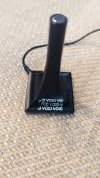Right. It's the "house curve" as many people label it. My feelings are that multEQ's default targets are flawed. I would assume you mean voice intelligibility during movies? I don't quite know what voicing is. My goal is for my home theater to sound like my nearfield studio monitor setup with minimal room interaction and near perfect FR. This is what most studios use to make the music and movies we are listening to, so why would I deviate? If these audyssey EQ tweaks of MRC and non-tilted Flat+HF rolloff were part of a speakers natural in-room estimated FR, then it would be an objectively poor speaker with a headless panther.
I haven't really changed anything with the overall tonality or "voicing" of my speakers in my room. My JBL 590's measure raw, in-room, very similar to the -3dB/decade Harman in room target if you ignore the room modes on the raw measurements.
As far as MRC(aka BBC dip), I deleted it. I'm puzzled why it's enabled by default. From what I gather, the BBC dip was created for ancient speakers with poor off-axis FR/directivity using a first order butterworth crossovers with a 2.0KHz +3dB hump (basically not using a
proper linkwitz Riley crossover). Any modern and objectively well regarded speaker is worse off using MRC. What about 3-ways or my compression driver having a low crossover point of ~1.2KHz?
In the end, I'm open to new ideas if you've got some compelling information to go against what I've found. Please, share.
Right now, I'm really interested in playing with my subwoofer placement to flatten the peaks and nulls before any room correction just by moving them in the room. So far, it hasn't been easy (monolith THX 13=heavy as hell), and the REW room simulator has limitations, but it's a good starting point. I'm really really excited for the next generation of room correction (spatial room correction?) using every speaker to deaden reflections or something to that effect.
View attachment 291300

